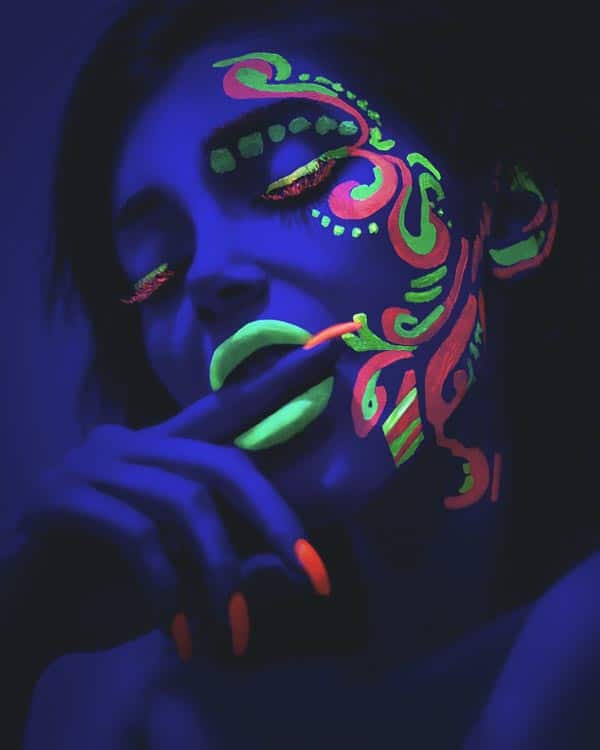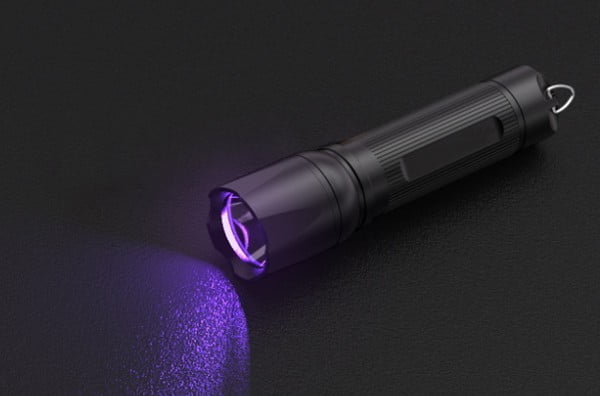Welcome to the topic of UV flashlights! In this guide, we will delve into the definition of a UV flashlight, the characteristics, uses, and benefits of UV flashlights, how to choose the right one for your needs, and some warm warnings about using a UV flashlight. Whether you are a professional in the business field or simply looking for a fun and practical tool to add to your collection, we hope you will find the information in this guide helpful and informative.
What’s a UV flashlight?
UV flashlight is short for an ultraviolet flashlight. UV flashlight is also known as a black light flashlight. UV flashlight is a flashlight with UV LED that can emit UV light.
Before talking about flashlights, let me introduce some basic knowledge about UV light. UV light is a type of electromagnetic radiation ranging from 100 nm to 400 nm. The wavelength range of light that humans can see is between 400 and 700 nanometers. So UV light is an invisible light to us.
When UV light shines on particular objects such as paints, dyes, minerals, animals, and body fluids exhibit fluorescence, they emit light in the visible spectrum called fluorescence. The other main feature of UV light is harmful to our skin.
UV light categories
UV light has shorter wavelengths than visible light. UV light is divided into three categories by wavelength: UVA, UVB, and UVC.
UVA
UVA is the light that emits ultraviolet (UV) radiation in the UV-A wavelength range of 315-400 nanometers (nm).
- Most of the UV (98.7%) from the sun that reaches us on the earth’s surface is of type UVA and is affected by the ozone.
- Fading of paints and dyes.
- UVA causes tan and early aging of the skin.
- UVA causes skin cancer called melanoma.
UVB
- UVB is the light that emits ultraviolet (UV) radiation in the UV-A wavelength range of 280-314 nanometers (nm).
- 1.3% of the UV from the sun reaches the earth’s surface and is highly affected by ozone. These rays are responsible for sunburn and tans on your skin and cause skin cancer.
- For vitamin D production, 270-300 nm wavelengths are stimulated.
UVC
- UVC is the light that emits ultraviolet (UV) radiation in the UV-A wavelength range of 100-217 nanometers (nm).
- UVC rays do not reach the earth’s surface as most are absorbed by atmospheric nitrogen, oxygen, and ozone; the rest are scattered.
- UVC is intense enough to combat pathogens. UVC is the best UV
- UVC is intense enough to combat pathogens. UVC is the only type of UV radiation that can be used for disinfection.
UV flashlight wavelength
Usually, the UV flashlight wavelength range is 350-400 nm. So, it belonged to UVA. So, a UV flashlight is also called a UVA flashlight.
What are the factors of a quality UV flashlight?
The basis of a good UV flashlight is the ability to emit enough invisible light.
So, to judge whether a UV flashlight is good, except for the standard specifications such as material, battery, size, and charger, the essential key points are wavelength, power, and efficiency of invisible emitting lights.
Wavelength
Why is wavelength so crucial for a UV light? Because ultraviolet light irradiates particular objects to induce fluorescence. The more fluorescent the UV light can create, the better. Not all wavelengths of UV light can produce sufficient fluorescence. Different wavelengths have different fluorescence effects. Most fluorescence is robust in the 320-380 nm range, with a peak at 365 nm.

Power
UV light is invisible, so we can’t use it like white by output lumens.
Generally, to know how much invisible light the flashlight can pump out is to see the power consumption, usually rated in watts. With the update in technology, the UV flashlight can be 1W, 2W, 5W, 10W, and more.
Even with the correct wavelength, UV flashlights can only create enough fluorescent effects with sufficient power.
The quantity of UV LED chips does not mean the flashlight can emit more UV light. It is the total power that matters. For example, the total power of 10 pieces of 0.5W LEDs is 5W. It is just equal to 1 piece of 5W LED chip.
The efficiency of emitting UV light
UV light is invisible, but we usually see a little purple light for most UV light. The reason is that LEDs emit invisible light and visible light. It means not all the watts are for invisible rays. Moreover, different led chips have different rates of invisible emitting lights, usually between 15% to 25%. We call this rate the efficiency of emitting UV light. A low-efficiency LED can mean that even a high-power UV flashlight produces little helpful UV light output.
How to choose a UV flashlight?
Based on the above, except for general specifications like material, size, battery, and charger, a good UV flashlight also depends on its wavelength, power, and efficiency of emitting UV light. For a UV flashlight, 365nm is the most powerful. And the fewer visible lights, the better.
What are the differences between 365nm and 395 nm?
Different occasions of use require different UV flashlights. It’s a good UV flashlight as long as it can meet the needs of your specific use cases.
The ordinary wavelength of a UV flashlight is close to 365 nm or 395 nm. A 365nm UV light can emit much more invisible light than 395nm.
Generally, a 365NM UV LED chip is much more expensive than 395nm. 395 nm LED products are lower in cost for those on a budget. 365 nm LED emits much less visible light than the 395 nm LED. Both types emit in the UV-A wavelength range. 365nm LED is more powerful, but a 395nm LED is more affordable.
Warm tip: Be aware that many products will not explicitly list the wavelength of UV used, or the wavelength data is hidden in small text, where you will find out that it may be over 400nm. These wavelengths are more accessible, cost less to manufacture, and result in weaker or nonexistent fluorescence effects than 395 nm black lights.
UV flashlight and uses
UV flashlight is typically used for a variety of applications, including:
Identifying counterfeit currency and documents
UV light can detect security features on money and documents that are invisible to the naked eye.
Detecting pet urine
UV light can locate pet urine on carpets and upholstery. The UV light will cause the urine to fluoresce, making it easier to spot and clean.
Detecting leaks
UV light can detect leaks in automotive and mechanical systems by illuminating the area with UV light and looking for a fluorescent dye that has been added to the system.
Analyzing minerals and rocks
UV light can identify minerals and rocks by how they fluoresce under UV light.
Detecting forgeries
UV light can detect fakes in art and antiques by revealing invisible details or markings to the naked eye.
Detecting bacteria
UV light can see bacteria in water or on surfaces by causing the bacteria to fluoresce.
Detecting scorpions
UV light can locate scorpions, as they fluoresce under UV light. Some scorpion is venomous and can often be deadly. So, having a UV flashlight in your pocket for walking home at night, camping, or any other nighttime activity can keep you away from danger.

Bed Bug Detector
Bed bugs are parasites that feed on human blood and can cause skin rashes or allergies. Bed bugs like to live in hotel rooms, airplane seats, public seats, dormitories, and carpets. Using a UV flashlight, you can find bed bug droppings or eggs and avoid taking them home to breed.
Checking for Hotel Cleanliness
Using a UV flashlight to check whether your hotel bedding is fresh or if your sheets have been recycled. Because the blood, urine, and semen emit fluorescence under ultraviolet radiation.
Entertainment
UV light can be used in entertainment settings, such as clubs and concerts, to create a unique atmosphere.

Find Evidence
UV flashlights are used by forensic or investigative personnel to investigate the crime scene and find evidence to solve the case.
Warm Warning
As mentioned above, UV flashlights belong to UVA light. The harm of UVA is similar to sunshine. It’s less harmful than UVB and UVC. However, there is always a particular risk of high-power UV radiation. It is vital to use UV flashlights safely and responsibly. Here are some precautions to consider:
- Avoid looking directly at the beam of the UV flashlight, as it might damage your eyes.
- Do not shine the UV flashlight in the eyes of people or animals, as it can cause discomfort and potentially harm their eyesight.
- Be aware that UV light can cause certain materials to fluoresce or glow. UV light can be valuable in some situations, but it can also be dangerous if it causes materials to ignite or explode.
- Follow the manufacturer’s instructions for using and handling the UV flashlight, as improper use can result in injury or damage.
- Wear appropriate protective gear when using a high-power UV flashlight, such as gloves and eye protection, to avoid coming into contact with potentially hazardous materials.
- Store the UV flashlight in a safe and secure location, out of the reach of children and pets, to prevent accidental injury or damage.
In conclusion, a UV flashlight is a valuable tool that can serve various purposes. It can identify counterfeit money, detect leaks in air conditioning systems, and identify specific types of bacteria and germs. We can use UV flashlights for recreational activities such as seeing phosphorescent materials or finding scorpions at night. However, it is essential to use caution when using a UV flashlight, as prolonged exposure to UV light can be harmful to the skin and eyes. With proper use, a UV flashlight can be a valuable addition to any toolkit.


